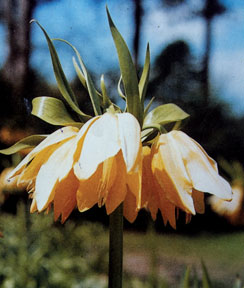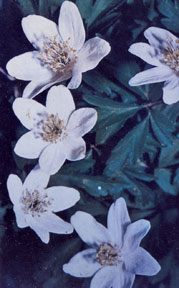|
William Shakespeare:
Flowers, the heart and soul of his plays
by Gwen Herat
‘There's a daisy, I would give you
Some violets, but they wither'd all
When my father died’ ... Hamlet, IV, V.
And how many times, just how many times I would have quoted this
dialogue when I acted the teenage Ophelia in the school's drama contest
I cannot recall but its essence of sentiment and frustration, still
lingers in me. Though very young, Hamlet changed my whole life.
 |
 |
| Long Purple |
Crown Imperial |
To William Shakespeare, flowers had a deeper meaning than beauty and
scent. They were the soul and spirit in his plays and sonnets. Most of
them are indicative and serve a purpose wherever used in the plays. They
play a pivotal role and make one feel the presence important not just
for appearance, but display the inspiration and depth of his ardour as
he showers upon them. He paints them more gloriously than a painter
would with a brush. It is evident as he picks the best to make Ophelia's
famous garland, both memorably sad and sensitive.
Skill
The flowers described by the bard with such matchless skill are still
found in the gardens and countryside of his native Warwickshire. A
countryman by birth, he was extremely fond of nature, and naturally
flowers. He had an intimate knowledge of them and could identify each
and all during the four seasons, much like a botanist though he was not.
The influence of his native Warwickshire reflects throughout his plays,
sonnets and poems. He put in beautiful alluring words into their systems
and aroused the imagination of the readers, in the process surprising
botanists with his intimate knowledge not only of flowers but also all
trees, shrubs and bushes.
Since both Shakespeare's parents came from farming families in the
country a few miles from each other, their influence was already upon
the growing child, Shakespeare. He would walk along the river banks of
Avon which again went into his plays, the forests around Arden's
woodlands and the open field pastures that linked the river-crossing
settlement. This environment clearly made on impression and made him
remain the countryman he was even though he was most of the time in
London. All these happenings around him, became the base for his future
writing.
Most of the gardens created during his lifetime remain the same
except few replanting the flowers and hedges that he had done. There is
a plant (I could not trace the name) at Hall's Croft Garden that has
been subject to cutting for replanting over and over again. Quite unique
I thought for it to be traced back to his lifetime. That is the passion
maintained by the gardeners and horticulturists working in the
Shakespeare Trust Gardens.
Daisy
His favourite flower was the Daisy which formed a part of Ophelia's
garland in Hamlet. It is one of the first flowers to come out in the
spring that is so characteristic of the English countryside, growing at
wayside, beside brooks and ‘neath spreading trees. Shakespeare
immortalised the daisy in Cymbaline when the Roman captain ordered his
men to make a grave with the prettiest daisies for the dead youth,
Cloten in the play
‘The boy hatch taught us manly duties. Let us
Find out the prettiest daisies plot we can.
And make him with our pikes and partisans,
A grave.’ ... Cymbaline, IV - II.
 |
|
Daffodils |
The daffodil is celebrated thrice over in the Winter's Tale. It is in
this play that a rouge named Autolycus speaks to Perdita with reference
to this flower, Shakespeare celebrates the golden daffodil's freshness
of spring and symbolises the youth to it.
Even the harsh winds of March cannot prevent the daffodils’ heralding
spring in woodlands and meadows even before the arrival of the swallow.
Another poet from England, William Wordsworth too captures the beauty of
the daffodil gloriously in his famous poem.
‘When daffodils begin to peer,
With hey, the doxy over the dale
Why then comes in the sweet o’ the year
For the red blood reigns in the winter's pale ... the winter's tale
IV; III Apparently, Shakespeare sees, much of golden yellow in his
flowers as he does on the dainty Cowslip and invests its beauty with
clusters of dainty golden yellow flowers with fairy character. He
applies the miniature cowslip to indicate the size of his dot-fairy,
Ariel in The Tempest and the song he sings we all know by heart.
‘Where the bee sucks, there suck I.
In a cowslip's bell I lie.
There I couch where owls do cry.
On the bat's back I do fly.
After summer merrily ... the Tempest V, I.
Again we come across Perdita in the Winter's Tale to whom the
Carnation was symbolic of her middle-age and refers to the season as
‘trembling winter’ or old age.
The carnation is found in every English garden in the past or at
present. The streaked and mixed colours, were produced by cross
pollination. Like the rose, this flower has undergone a series of cross
pollination as well as ‘budding. Of Carnation Shakespeare declares;
Sir, the year growing ancient,
Not yet on summer's death, nor on birth
of trembling winter, the fairest flowers o’ the season
Are our carnations and streaked gillyvors
Which some call nature's bastards....
... then make your garden rich in gillyvors
And do not call them bastards ... the winter's Tale, IV, IV.
Every growing flower of the day, has come under Shakespeare's
reference and among them, the rose, lily and carnation are common to Sri
Lanka. Most of the flowers mentioned by the bard are still found at his
Birthplace,
I have seen on my numerous visits to his gardens. One flower that
intrigued me was the Crown Imperial which I have never seen in any other
part of the world.
Shakespeare was familiar with all the wild and cultivated flowers
around his habitat:
The flowers used with their botanical terms.
 |
|
Primrose |
Aconituem – Aconitum napellus
Carnation – Diantus caryophyllus
Cowslip – Primula veris
Crown Imperial – Frittillaria imperials
Cuckoo-Bud – R nunculus acris
Daisy – Bellis perernis
Harebell – Campanula rotundifolia
Lady-smock – Cardamine pratenis
Long Furple – Arum Maculatum
Oxlip – Primula elatior
Pink – Dianthus
Viloet – Viola odorata
Adonis Flower – Fritillaria melaagris
Columbine – Aquilegia vulgaris
Crowflower – Lychnis flos-caculi
Daffodil – Narissus pseudonarissus
Eglantine – Rosa rubiignosa
Honeysuckle – Lonicera periclymenum
Lily – Lilium candidum
marigold – Caltha palustris
Pansy – Viola tricolor
Primrose – Rosa
|


